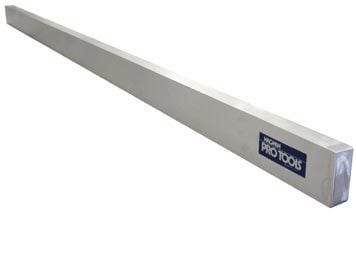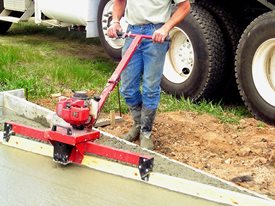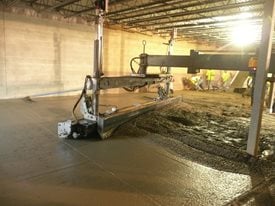- Concrete Tools Home
- Screeds
- Tampers
- Concrete Floats
- Concrete Edgers
- Groovers
- Trowels
- Fresnos
- Power Tools for Concrete
- Choosing the Best Tool for the Job
- Must-Have Tools for Exterior Concrete: The five tools outdoor concrete contractors can’t live without
- Five Must-Have Tools for Decorative Flooring Contractors Create eautiful decorative concrete floors with these five tools
- Five Must-Have Tools for Concrete Countertop Contractors
- Related Information:
- Pouring and Finishing Tool Videos: See demonstrations of floating, troweling, edging, and more
- Concrete Finishing Tips: Creating a high-quality slab
- Product Newsletter: Sign up today to receive monthly updates
Tools for Screeding Concrete - Straightedges & Power Screeds
How to use screeds and straightedges to strike off and level freshly placed concreteStraightedges are used to "strikeoff" or "screed" the concrete. This process removes excess concrete and brings the top surface of the concrete to proper grade.
This step in the finishing operation is the most important in producing a true plane surface and takes place immediately after the spreading of the concrete. It must be completed before excess bleedwater appears on the surface.
There are a wide variety of screeding tools—both hand tools (wood and magnesium) and mechanical tools (vibratory, oscillating, and roller). The important thing for this discussion is what they achieve and when screeding must be done.
SCREEDS & STRAIGHTEDGES
Purpose: To strike off freshly placed concrete and make it as level as possible before finishing.
What's available: You can use a simple wood 2x4, or purchase hollow aluminum or magnesium straightedges. Metal straightedges are available in various lengths (from 6 to 24 feet) and cross sections.
Buying tips:
-
Wood straightedges should be straight and warp-free. Otherwise, they can leave undesirable ruts or crowns in the concrete surface.
-
Magnesium and aluminum straightedges are lighter than wood and won't warp or bow. They also are easier to clean because concrete won't stick to them.
-
Buy metal straightedges with capped ends to keep out wet concrete. Some tools have wooden or plastic plugs in the ends, but these can fall out and allow the concrete to enter. Tools with welded metal end caps are a better bet.
-
For more comfortable grasping, look for straightedges with kerfed edges that won't dig into your hands during use. You can also find keyhole-shaped straightedges with flat bottoms and rounded tops for easier gripping.
-
To help you gauge surface slope as you work, consider buying a straightedge with built-in or clamp-on bubble levels.
-
For large jobs, such as commercial slabs, consider a power screed.
Average costs: The cost for a wood 2x4 will be nominal and you might be able to use a piece of lumber you already have on the job. A 2x4 magnesium straightedge goes for about $75 (6-foot length) to $300 (24-foot length).
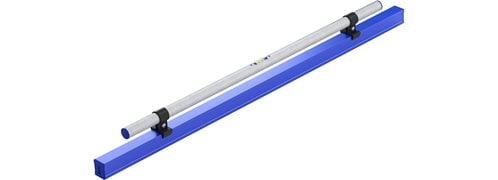 Bon 82-462 Kangaroo Combo Screed
Extruded aluminum with a level in the handle.
Bon 82-462 Kangaroo Combo Screed
Extruded aluminum with a level in the handle.
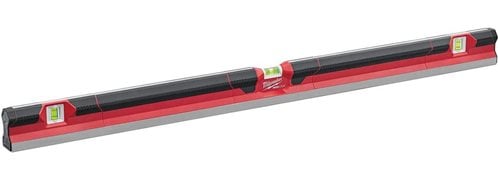 48" REDSTICK Concrete Screed Level
Magnesium base for screeding, smoothing, and easy cleaning.
48" REDSTICK Concrete Screed Level
Magnesium base for screeding, smoothing, and easy cleaning.
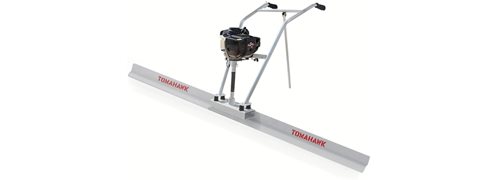 TOMAHAWK Power Screed
Uniform vibration over the length of the blade.
TOMAHAWK Power Screed
Uniform vibration over the length of the blade.
POWER SCREEDS
A simple 2x4 and a fresno may work fine when it comes to leveling and finishing a small residential slab, like a sidewalk or patio, but to place large driveways and sprawling commercial or industrial slabs, you’ll need equipment with a lot more speed and efficiency. For projects of this scale, contractors typically rely on power screeds, not only to improve productivity but also to ensure a smooth, level surface. Here’s an overview of your equipment options.
Vibrating ScreedsVibrating screeds feature a metal screed blade attached to a handle that allows finishers to smooth and level fresh concrete from a standing position. A motor produces the vibrating action, reducing the effort required by the operator, who only needs to pull the screed across the surface. Screed blade lengths range from 4 to 16 feet, and the blades can be removed and replaced. Most vibrating screeds are gasoline powered, but some models are available in a battery-powered version. Applications include residential driveways, large patios and other slabs that don’t require extreme flatness. Features to look for include quick-change screed blades, variable speed control, ergonomic design and adjustable handles. Keep in mind that although a longer screed blade length will cover more surface area in one pass, it will be more cumbersome to maneuver, especially in tight spots. Top manufacturers of vibrating screeds include TOMAHAWK, Marshalltown, and Northern Industrial Tools.
Laser ScreedsThese high-tech screeds are ideal for striking off commercial and industrial concrete floors that must meet stringent F-number tolerances (see Understanding F-Number Requirements for Commercial and Industrial Floors). The screed head comes in various widths, ranging from 12 to 20 feet, and is mounted on a self-propelled four-wheel drive machine with a telescoping boom that extends up to 20 feet across the slab. The screed head is equipped with a plow, auger and vibrator to disperse the fresh concrete, remove excess material to finished grade, and smooth the surface. Laser receivers mounted at each end of the screed head receive a signal from a transmitter to automatically strike off the floor to specified flatness levels. Top manufacturers of laser screeds include Somero Enterprises, Ligchine International and Allen Engineering.
